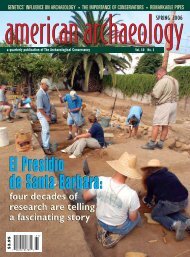Clovis Comet Debate - The Archaeological Conservancy
Clovis Comet Debate - The Archaeological Conservancy
Clovis Comet Debate - The Archaeological Conservancy
Create successful ePaper yourself
Turn your PDF publications into a flip-book with our unique Google optimized e-Paper software.
soil from seven well-dated <strong>Clovis</strong> sites. “It was one of the<br />
most difficult, labor intensive tasks I’ve ever undertaken,” he<br />
says. “I had to extract the magnetic particles, sprinkle them<br />
on a slide, look at them through a microscope, and count<br />
them. I spent 16 months on the project and over a hundred<br />
hours in the lab. I found no peaks in microspherules at the<br />
start of the Younger Dryas. I could find no support for an<br />
extraterrestrial impact.”<br />
University of Hawaii geologist Francois Paquay couldn’t<br />
either. He checked <strong>Clovis</strong>-age soil samples for high levels of<br />
iridium, a silvery white metal. Iridium served as a definitive<br />
marker for meteorite impact that marked the end of the age<br />
of dinosaurs, but he found little evidence of the metal in the<br />
samples.<br />
University of Wisconsin-Madison paleoecologist Jacquelyn<br />
Gill examined <strong>Clovis</strong>-age lake sediments in Indiana and<br />
Ohio for unusual levels of charcoal, magnetic grains, silicate<br />
spheres, titanium, and chromium—all suggested as diagnostic<br />
signatures by Firestone and his team. She reported “no<br />
physical trend to suggest an impact event.”<br />
Andrew Scott, a University of London geologist, did<br />
find something when he examined <strong>Clovis</strong>-age sediments in<br />
search of carbon spherules the PNAS authors claim is evidence<br />
of an impact, but it wasn’t what they had been hoping<br />
for. He says the organic particles were merely “fecal pellets<br />
from insects, plant or fungal galls, and wood, some of which<br />
may have been exposed to regularly occurring low-intensity<br />
wildfires.”<br />
<strong>The</strong> comet proponents maintain that the most persuasive<br />
evidence of an extraterrestrial impact is the discovery, at<br />
six <strong>Clovis</strong>-age sites across North America, of nanodiamonds—<br />
diamonds that are mere billionths of a meter in diameter—<br />
that they say could only be produced in the intense heat and<br />
pressure of the massive impact.<br />
<strong>Clovis</strong> comet proponents believe an extraterrestrial impact<br />
produced this microscopic diamond found at the<br />
Arlington Springs site in California.<br />
Archaeologist Todd Surovell measured the amount of magnetic<br />
microspherules in soil samples taken from seven <strong>Clovis</strong> sites.<br />
After placing the samples in water (top), he extracted the microspherules<br />
using an extremely powerful magnet wrapped in a plastic<br />
bag (middle). <strong>The</strong> microspherules, which adhered to the bag, were<br />
then cleaned in a series of baths (above). He did not find an increase<br />
in microspherules that would corroborate the comet theory.<br />
“<strong>The</strong> concentrations of nanodiamonds we found at all<br />
six locations exist only in sediments associated with the<br />
Younger Dryas boundary layer, not above it or below it,”<br />
says archaeologist Doug Kennett. “<strong>The</strong>se discoveries provide<br />
strong evidence for a cosmic impact event at approximately<br />
12,900 years ago that would have had enormous environmental<br />
consequences for plants, animals, and humans across<br />
North America.”<br />
But some geologists aren’t so sure. As part of a comprehensive<br />
look at all of the 175 craters caused by extraterrestrial<br />
impacts, Bevan French of the Smithsonian Institution<br />
and Christian Koeberl the University of Vienna also looked<br />
at the <strong>Clovis</strong> comet claims. <strong>The</strong>y reported that while microscopic<br />
diamonds might, in some cases, be the result of a collision,<br />
they are not proof positive. <strong>The</strong>y concluded that “none<br />
16 fall • 2010<br />
nicole WagUeSpack<br />
allen WeST




